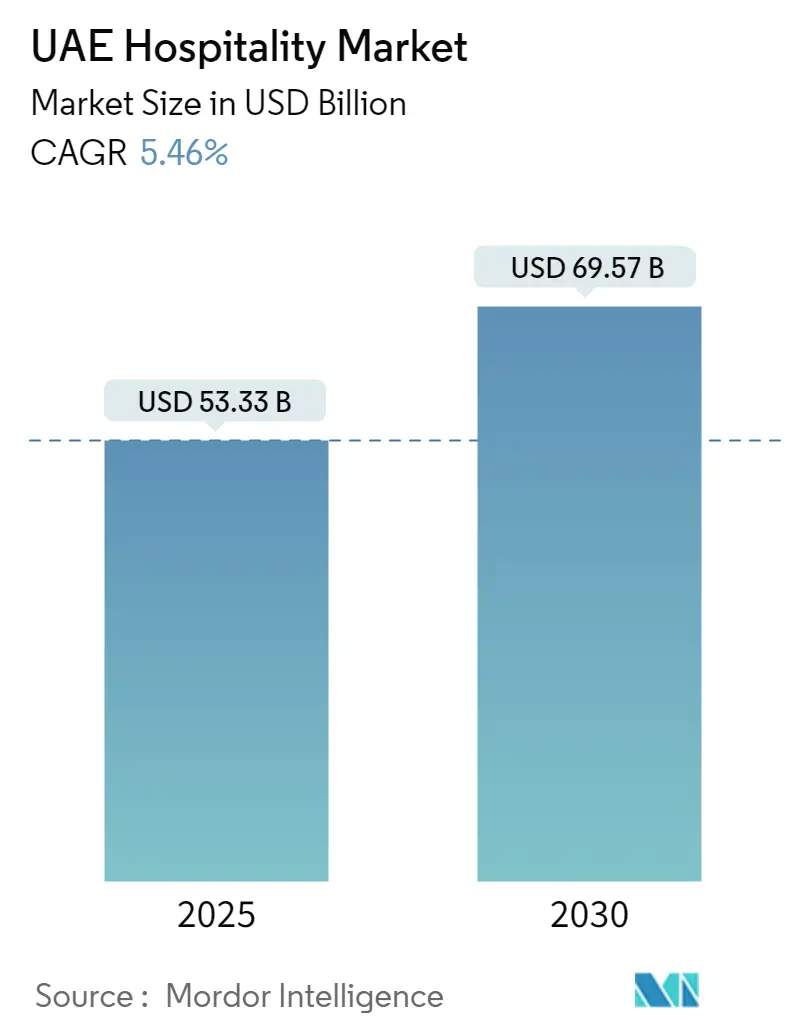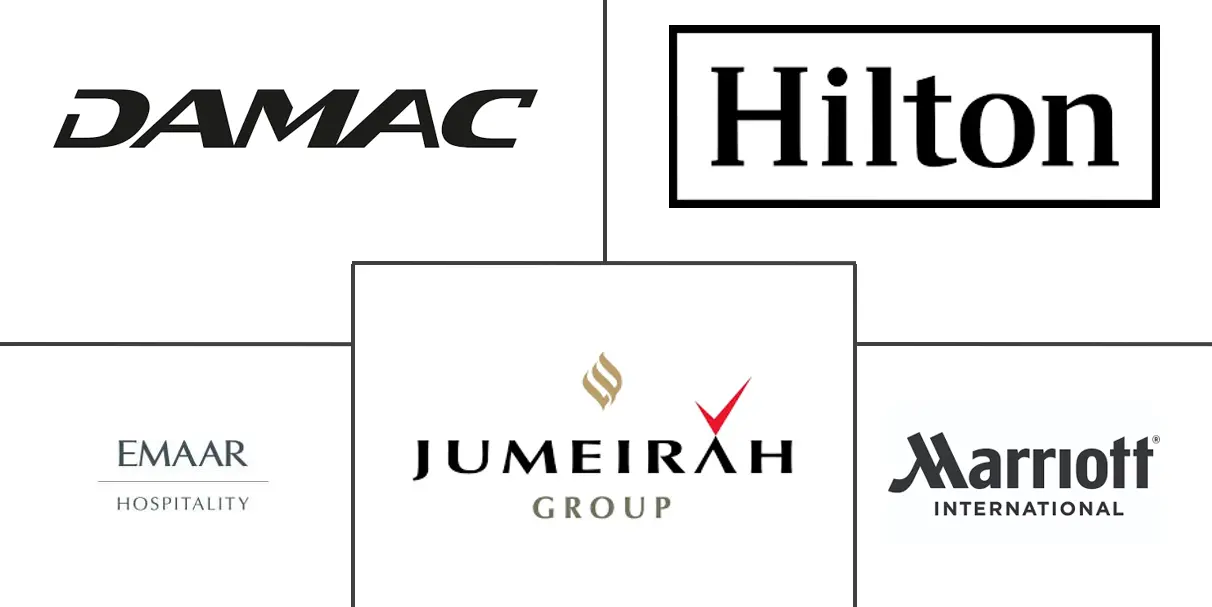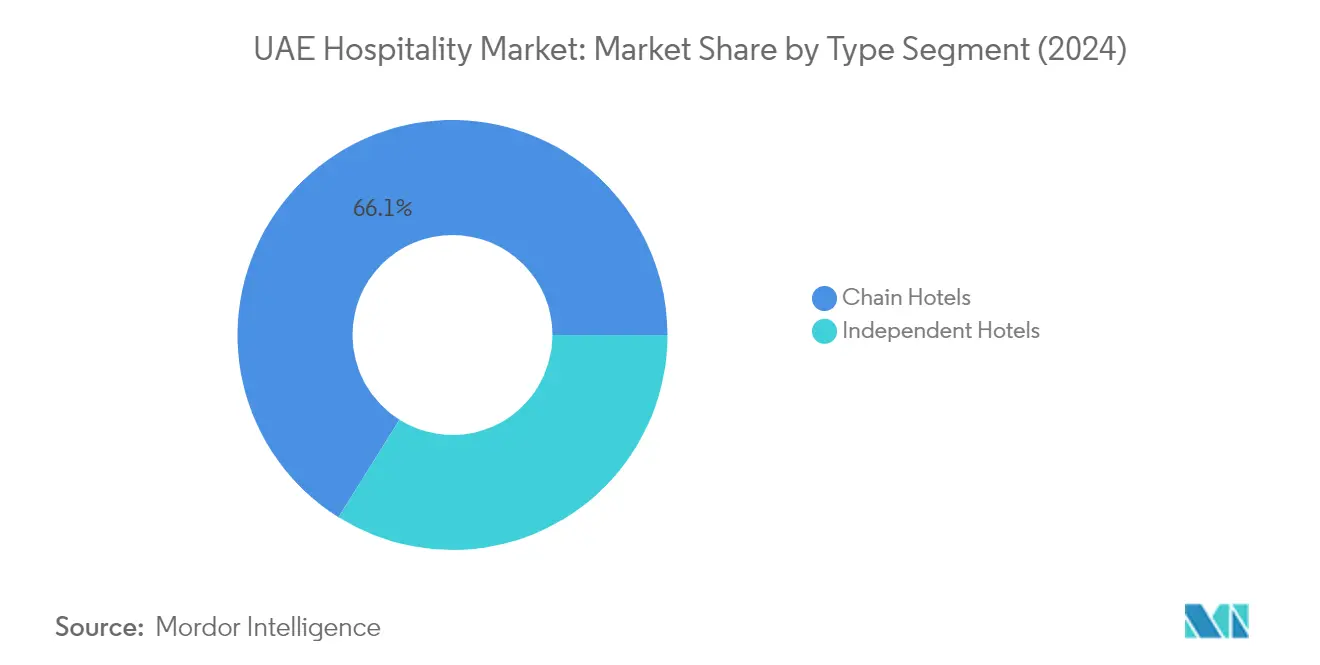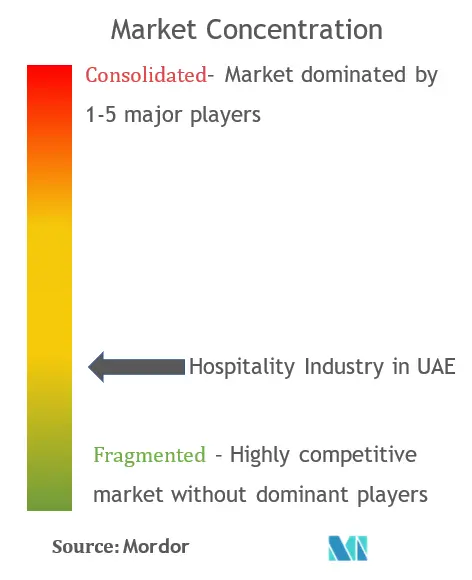
| Study Period | 2020 - 2030 |
| Base Year For Estimation | 2024 |
| Forecast Data Period | 2025 - 2030 |
| Market Size (2025) | USD 53.33 Billion |
| Market Size (2030) | USD 69.57 Billion |
| CAGR (2025 - 2030) | 5.46 % |
| Market Concentration | Medium |
Major Players
*Disclaimer: Major Players sorted in no particular order |
UAE Hospitality Market Analysis
The UAE Hospitality Market size is estimated at USD 53.33 billion in 2025, and is expected to reach USD 69.57 billion by 2030, at a CAGR of 5.46% during the forecast period (2025-2030).
The UAE hospitality industry continues to demonstrate robust growth, supported by significant infrastructure investments and property developments. The sector reached a milestone with 1,186 hotels and similar establishments operating in 2022, reflecting the country's commitment to expanding its hospitality infrastructure. Capital investment in the hotels and tourism sector reached AED 4,453.22 million in 2022, positioning it as the second-largest recipient of capital investment across all sectors in the UAE. This substantial investment has facilitated the development of world-class hospitality facilities and the entry of international hotel brands, strengthening the UAE's position as a premier global hospitality destination.
The luxury segment maintains its dominance in the UAE hospitality landscape, with a strong pipeline of premium developments reshaping the market. Current development plans include 118 new hotel projects scheduled for completion between 2023 and 2025, with 64% of these projects falling in the five-star category. The strategic focus on luxury accommodations aligns with the UAE's vision to attract high-value tourists and maintain its reputation as a luxury travel destination. This expansion of premium properties is complemented by innovative amenities and services, including technology-driven guest experiences and sustainable building practices.
Alternative accommodation options are gaining traction in the UAE hospitality sector, particularly in the vacation rental segment. The market has shown impressive growth, with vacation rental revenue reaching USD 319.1 million in 2023, demonstrating increasing consumer preference for flexible and diverse accommodation options. This trend is driven by changing traveler preferences, with many seeking more personalized and home-like experiences during their stays. The rise of digital platforms and improved regulatory frameworks has facilitated this growth, making it easier for property owners to participate in the short-term rental market.
The UAE's hospitality sector is undergoing significant transformation through strategic development initiatives and property launches. Room revenue has shown strong recovery, reaching AED 18.23 billion in 2021, indicating robust demand for hospitality services. The industry's development pipeline remains strong, with 58 hotel projects completed in 2022 and 32 more scheduled for 2023, showcasing continued investor confidence in the market. These developments are strategically distributed across various emirates, with Dubai leading in new hotel openings, followed by significant projects in Abu Dhabi, Sharjah, and Ras Al Khaimah, contributing to the diversification of the UAE's hospitality offerings.
UAE Hospitality Market Trends
Growing Tourism Sector and International Recognition
The United Arab Emirates' hospitality market is experiencing substantial growth driven by the robust tourism sector, which has become a cornerstone of the nation's economic development strategy. This is evidenced by tourism's significant contribution to the GDP, reaching 10.14% in the first half of 2023, demonstrating the sector's vital role in the country's economic diversification efforts. The international recognition of the UAE's tourism excellence, particularly Dubai being named the world's best-traveled destination at the Tripadvisor Travelers' Choice Best of the Best Destination Awards 2023, has further strengthened its position as a premier global tourist destination.
The strategic focus on tourism and leisure development, particularly through initiatives like the Dubai Economic Plan D33, continues to drive the hospitality sector's growth. The UAE has successfully positioned itself as a world-class tourism destination by maintaining its commitment to innovation and development in the hospitality sector. This dedication to excellence has resulted in millions of visitors choosing the UAE as their preferred destination, creating a sustained demand for hospitality services and accommodations throughout the year.
Rapid Expansion of Luxury Hospitality Infrastructure
The UAE hospitality market is witnessing unprecedented growth through extensive luxury hotel development projects, with over 130 premium sites and approximately 34,000 rooms in the pipeline for the country's top-end hotel sector. The market's strong focus on luxury accommodation is reflected in the fact that 64% of the high-end pipeline is in the five-star category, comprising 83 distinct sites. This substantial investment in luxury hospitality infrastructure demonstrates the market's confidence in the continued demand for high-end accommodations and services.
The rapid pace of development is evident in the current construction timeline, with 68 properties scheduled for completion in the immediate future, representing 52% of the premium pipeline. This expansion is further exemplified by innovative projects such as The Heart of Europe, a self-sufficient luxury resort located six kilometers into the sea among the World Islands. This development, which will feature sixteen hotels and holiday resorts inspired by major European cities, showcases the UAE's commitment to creating unique and ambitious hospitality projects that set new standards for luxury accommodation and attract high-value tourists from around the world.
Strategic Infrastructure Development and Innovation
The UAE's hospitality market is significantly bolstered by the country's commitment to large-scale infrastructure development and innovative projects that enhance its appeal as a tourist destination. Major developments, particularly in Dubai, are creating new attractions and experiences that drive tourism growth and support the hospitality sector. These infrastructure initiatives go beyond traditional hotel developments to include integrated resorts, themed destinations, and unique architectural projects that differentiate the UAE in the global tourism market.
The emphasis on innovation is exemplified through projects like The Heart of Europe, which represents a new generation of hospitality developments that combine luxury accommodation with unique experiences. This innovative approach to hospitality infrastructure extends to the development of self-sufficient resorts and themed properties that cater to evolving tourist preferences. The strategic placement and design of these developments, along with their integration into the broader urban landscape, create distinctive hospitality experiences that attract visitors and drive demand for accommodation services throughout the Emirates. Furthermore, the integration of hospitality technology enhances the guest experience, ensuring that the UAE remains at the forefront of hospitality management.
Segment Analysis: By Type
Chain Hotels Segment in UAE Hospitality Market
Chain hotels dominate the UAE hospitality market, commanding approximately 66% market share in 2024, driven by the strong presence of international and national hotel chains like Marriott International, Accor Hotels, Hilton, and Four Seasons. The segment's prominence is attributed to the country's high demand from leisure and business travelers, coupled with the expansion of housing and investment projects in a rapidly growing economy. The segment is experiencing robust growth with a projected rate of around 6% from 2024 to 2029, supported by multiple national and international players increasing their presence in the country over recent years. The growth is particularly driven by foreign visitors' preference for upscale service, privacy, and comfort, leading to increased demand for star-rated hotels and resorts. Major hotel chains continue to expand their footprint in the UAE, with several new properties under development, particularly in luxury and upscale segments, further strengthening their market position.

Independent Hotels Segment in UAE Hospitality Market
The independent hotels segment in the UAE hospitality market offers a unique value proposition through personalized experiences and cultural authenticity. These establishments operate independently and cater to tourists seeking to experience the country's culture more intimately. Independent hotels have positioned themselves effectively by offering all-inclusive packages with various accommodation types, including villas, resorts, and rooms with comfort features, family or couples' suites, spas, and therapies at more competitive prices than international chains. The segment's success is driven by the growing preference among travelers for authentic experiences and value for money, with customer reviews often carrying more weight than brand reputation in property selection. Notable independent properties like Media One Hotel and The H Hotel have gained popularity among travelers seeking both luxury and mid-market options, demonstrating the segment's ability to compete effectively despite its smaller scale.
Segment Analysis: By Segment
Luxury Hotels Segment in UAE Hospitality Market
The luxury hotels segment continues to dominate the UAE hotel industry, commanding approximately 54% of the total market share in 2024. This substantial market presence is driven by the UAE's reputation as a premier luxury travel destination, particularly in Dubai and Abu Dhabi. The segment benefits from high-spending international tourists, business travelers, and the growing demand for ultra-luxury experiences. The UAE's luxury hotels are known for their iconic architecture, world-class amenities, and exceptional guest service standards, with many properties featuring signature restaurants, premium spa facilities, and exclusive beach access. The segment's strength is further reinforced by continuous investments in new luxury properties and renovations of existing ones, maintaining the UAE's position as a global luxury hospitality hub.
Mid and Upper Mid-scale Hotels Segment in UAE Hospitality Market
The mid and upper mid-scale hotels segment is emerging as the fastest-growing category in the UAE hospitality market, with a projected growth rate of approximately 6% during 2024-2029. This robust growth is driven by increasing demand from business travelers, middle-class tourists, and domestic travelers seeking quality accommodations at more accessible price points. The segment is experiencing significant expansion through new property developments, particularly in emerging business districts and secondary locations. These hotels are strategically positioning themselves to capture the growing middle-class tourism market while maintaining high guest service standards and essential amenities that appeal to both leisure and business travelers.
Remaining Segments in UAE Hospitality Market
The service apartments and budget and economy hotels segments play crucial roles in diversifying the UAE's hospitality offerings. Service apartments cater to long-stay guests, expatriate families, and corporate travelers seeking home-like amenities and flexibility in their lodging. These properties typically offer fully-furnished units with kitchen facilities and additional living space. The budget and economy hotels segment serves price-sensitive travelers, including transit passengers, small business travelers, and tourists looking for cost-effective accommodations without compromising on essential amenities and comfort. Both segments contribute to making the UAE's hospitality market more accessible and diverse, appealing to a broader range of travelers with varying preferences and budgets.
UAE Hospitality Industry Overview
Top Companies in UAE Hospitality Market
The UAE hospitality market features prominent international chains like Marriott International, Hilton Worldwide, and Accor, alongside strong regional players such as Emaar Hospitality Group, Rotana Hotels, and Jumeirah Hotels & Resorts. The industry demonstrates robust product innovation through the continuous introduction of new hospitality concepts, lifestyle brands, and hospitality technology-driven guest experiences. Companies are showing remarkable operational agility by diversifying their portfolios across different market segments, from luxury to mid-scale offerings, while implementing sustainable practices and digital transformation initiatives. Strategic moves in the market are characterized by an increasing focus on branded residences, mixed-use developments, and serviced apartments, particularly in key destinations like Dubai and Abu Dhabi. Market expansion is driven by aggressive development pipelines, with companies pursuing both organic growth through new property launches and inorganic growth through strategic partnerships and management contracts.
Dynamic Market with Strong Local Leadership
The UAE hospitality market exhibits a unique blend of global hotel and hospitality conglomerates and well-established local players, with domestic companies like Emaar Hospitality and Al Habtoor Group wielding significant influence through their integrated development approach and deep market understanding. The market structure is characterized by a moderate level of consolidation, where major international chains maintain a substantial presence through management contracts, while local conglomerates leverage their real estate expertise to develop and operate distinctive hospitality services assets. The competitive dynamics are further shaped by the presence of government-backed entities and diversified business groups that bring substantial financial resources and long-term strategic vision to their hospitality ventures.
The market demonstrates active merger and acquisition activity, particularly in the luxury and upper-upscale segments, where international operators seek to strengthen their presence through strategic partnerships with local real estate developers and investment groups. The competitive landscape is evolving with the emergence of lifestyle-focused brands and specialized operators targeting specific market niches, from boutique luxury properties to smart mid-market hotels. Local players are increasingly partnering with international brands to enhance their operational capabilities and global distribution reach, while maintaining their competitive advantage through local market knowledge and established relationships.
Innovation and Adaptability Drive Market Success
For incumbent players to maintain and expand their market share, the focus needs to be on continuous innovation in hospitality management, operational efficiency through technology adoption, and strategic asset management to optimize portfolio performance. Success strategies include developing distinctive brand positioning, investing in sustainability initiatives, and creating unique value propositions that resonate with evolving guest preferences. Market leaders are increasingly emphasizing the importance of building strong loyalty programs, enhancing digital capabilities, and maintaining pricing power through service differentiation and market segmentation strategies.
Emerging contenders in the market can gain ground by identifying and capitalizing on underserved market segments, particularly in the mid-market and lifestyle categories where demand continues to grow. The relatively low substitution risk from alternative accommodation options like serviced apartments and vacation rentals provides stability for traditional hotel operators, though success requires careful attention to changing consumer preferences and regulatory requirements. The regulatory environment, particularly regarding tourism development and hospitality operations, remains supportive while emphasizing sustainability and quality standards, creating opportunities for operators who can effectively align their strategies with these requirements.
UAE Hospitality Market Leaders
-
Marriott International Inc
-
Hilton Worldwide Holdings Inc
-
Jumeirah Group
-
Emaar Hospitality Group
-
DAMAC Properties
- *Disclaimer: Major Players sorted in no particular order

UAE Hospitality Market News
- April 2023: The Dubai-based Hospitality Management Holding (HMH) Group announced plans to unveil 18 new hotels in the Arabian Travel Market. During the event, the Group showcased its regional hospitality projects and signed new partnership deals. HMH is expected to use this platform to reveal its forthcoming strategies and international expansion plans.
- March 2023: IHG Hotels & Resorts, a global leader in the hotel industry with over 6,000 hotels worldwide, made headlines with the debut of Voco Dubai The Palm, a new beachfront hotel on the renowned Palm Jumeirah.
UAE Hospitality Market Report - Table of Contents
1. INTRODUCTION
- 1.1 Study Assumptions and Market Definition
- 1.2 Scope of the Study
2. EXECUTIVE SUMMARY
3. RESEARCH METHODOLOGY
4. MARKET INSIGHTS AND DYNAMICS
- 4.1 Market Overview
-
4.2 Market Drivers
- 4.2.1 Rising Tourism in the United Arab Emirates Bolsters the Growth in Hospitality Sector
- 4.2.2 The Rise in the Mice Industry in the United Arab Emirates Drives the Hospitality Sector
-
4.3 Market Restraints
- 4.3.1 High Rentals in the United Arab Emirates Pose a Restraint to the Hospitality Sector
-
4.4 Market Opportunities
- 4.4.1 Adopting Sustainable Practices, Such as Energy-Efficient Buildings
- 4.5 Value Chain/Supply Chain Analysis
-
4.6 Industry Attractiveness: Porter's Five Forces Analysis
- 4.6.1 Bargaining Power of Buyers
- 4.6.2 Bargaining Power of Suppliers
- 4.6.3 Threat of New Entrants
- 4.6.4 Threat of Substitutes
- 4.6.5 Intensity of Competitive Rivalry
- 4.7 Insights on Revenue Flow From the Accommodation and Food and Beverage Sector
- 4.8 Leading Cities In United Arab Emirates With Respect to the Number of Visitors
- 4.9 Investments (Real Estate, Fdi, and Others) In the Hospitality Industry
- 4.10 Technological Innovations In the Hospitality Industry
- 4.11 Insights on Shared Living Spaces Impact on the Hospitality Industry
- 4.12 Insights on Other Economic Contributors to the Hospitality Industry
- 4.13 Impact of Covid-19 on Hospitality Industry
5. MARKET SEGMENTATION
-
5.1 By Type
- 5.1.1 Chain Hotels
- 5.1.2 Service Apartments
- 5.1.3 Independent Hotels
-
5.2 By Segment
- 5.2.1 Budget and Economy Hotels
- 5.2.2 Mid and Upper mid scale Hotels
- 5.2.3 Luxury Hotels
6. COMPETITIVE LANDSCAPE
- 6.1 Market Concentration
-
6.2 Company Profiles
- 6.2.1 Marriott International
- 6.2.2 Hilton Worldwide Holdings
- 6.2.3 Emaar Hospitality Group
- 6.2.4 Rotana Hotels
- 6.2.5 DAMAC Group
- 6.2.6 Jumeirah Hotels & Resort
- 6.2.7 Hyatt Hotel Corporation
- 6.2.8 Al Habtoor Group
- 6.2.9 Majid Al Futtaim
- 6.2.10 Abu Dhabi National Hotels
- 6.2.11 Accor SA
- 6.2.12 Danat Hotels & Resorts
- *List Not Exhaustive
7. FUTURE OF THE MARKET
8. ABOUT US
UAE Hospitality Industry Segmentation
The hospitality industry encompasses various businesses and services related to lodging, dining, event planning, theme parks, transportation, and other activities catering to travelers, tourists, and residents seeking leisure, recreation, and entertainment experiences.
The hospitality industry in the United Arab Emirates is segmented by type and segment. By type, the industry is segmented into chain hotels, service apartments, and independent hotels. By segment, the industry is divided into budget and economy hotels, mid and upper-mid-scale hotels, and luxury hotels. The reports offer market sizing and forecasts in value (USD) for all the above segments.
| By Type | Chain Hotels |
| Service Apartments | |
| Independent Hotels | |
| By Segment | Budget and Economy Hotels |
| Mid and Upper mid scale Hotels | |
| Luxury Hotels |
UAE Hospitality Market Research FAQs
How big is the UAE Hospitality Market?
The UAE Hospitality Market size is expected to reach USD 53.33 billion in 2025 and grow at a CAGR of 5.46% to reach USD 69.57 billion by 2030.
What is the current UAE Hospitality Market size?
In 2025, the UAE Hospitality Market size is expected to reach USD 53.33 billion.
Who are the key players in UAE Hospitality Market?
Marriott International Inc, Hilton Worldwide Holdings Inc, Jumeirah Group, Emaar Hospitality Group and DAMAC Properties are the major companies operating in the UAE Hospitality Market.
What years does this UAE Hospitality Market cover, and what was the market size in 2024?
In 2024, the UAE Hospitality Market size was estimated at USD 50.42 billion. The report covers the UAE Hospitality Market historical market size for years: 2020, 2021, 2022, 2023 and 2024. The report also forecasts the UAE Hospitality Market size for years: 2025, 2026, 2027, 2028, 2029 and 2030.
Our Best Selling Reports
UAE Hospitality Market Research
Mordor Intelligence provides a comprehensive analysis of the UAE hospitality sector. We leverage our extensive expertise in tourism and leisure research. Our detailed report examines the complete ecosystem, including lodging, accommodation, and resort facilities. It also covers the growing HORECA segment. The analysis encompasses hospitality services across major emirates, from hotel industry dynamics to vacation rental trends. Additionally, it addresses business tourism patterns and commercial accommodation developments.
Stakeholders gain actionable insights through our report PDF, which is available for download. It covers hospitality technology adoption, hospitality software implementation, and guest experience enhancement strategies. The analysis examines hospitality management practices, the evolution of catering services, and the optimization of hospitality facilities. Our research spans the entire value chain, from hospitality equipment to hospitality real estate developments. It provides a detailed examination of food and beverage hospitality operations. The report also explores how guest service innovations and the convergence of hospitality and entertainment are reshaping the industry landscape. This offers valuable insights for decision-makers in the travel and hospitality sectors.




